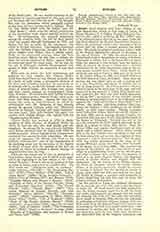

Byblos, a titular see of Phoenicia. Byblos is the Greek name of Gebai “The mountain”, one of the oldest cities in Phoenicia Prima, quoted in an Egyptian inscription as early as 1550 B.C. Its inhabitants were skilled in stone and wood-working (III Kings, v, 18) and in shipbuilding (Ezech., xxvii, 9). It was governed by kings, the last of whom was dethroned by Pompey. It is celebrated chiefly for its temple of Adonis, or Thammouz, whose voluptuous worship spread thence over Greece and Italy. It was the native place of Philo, a Greek historian and grammarian. As a Christian see it was suffragan to Tyre and according to one tradition, its first bishop was John Mark, the companion of St. Paul and St. Barnabas. Five other bishops are known before 553 (Lequien, Or. Chr., II, 821). The city was destroyed by an earthquake in 551 (Malalas, Chronogr., XVIII, P.G., XVVII, 704) and was in ruins as late as 570 (Pseudo-Antoninus, ed. Geyer, 159). The Crusaders took it in 1104; it then had a Greek bishop, but he was obliged to yield his see to a Latin successor, and from 1.130 to 1500 about twenty Latin bishops are known (Lequien, Or. Chr., III, 1177; Eubel, Hier. Cath., I, 139; II, 119). Many Latin bishops are mentioned in “Revue Benedictine”, 1904, 98, sqq.; 1907, 63, sq. The modern Arabic name is Gebail. It is a mere village with about 1,000 inhabitants, almost all Christians (650 Maronites). There are thirteen churches; three of them are very beautiful and trace their origin to the Crusades. There is also at Byblos a castle of the same time, likewise some ruins of temples of Adonis and Isis. Gebail is yet a diocese for the Orthodox Greeks. For the Catholic or Melchite Greeks, the title of Byblos is united with Beirut, and for the Maronites with that of Batroun (Botrys).
S. VAILHE

